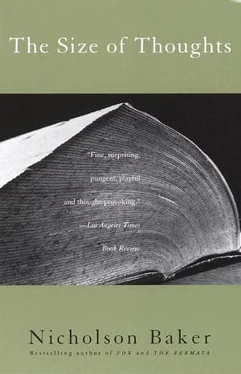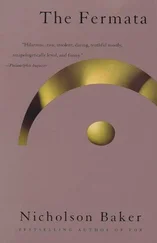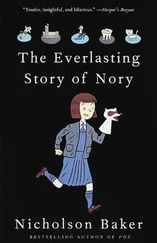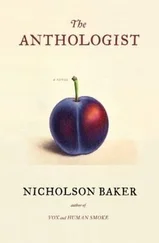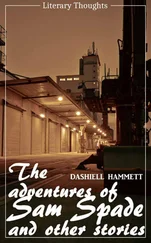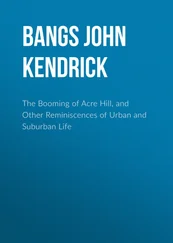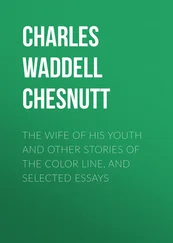Nicholson Baker - The Size of Thoughts - Essays and Other Lumber
Здесь есть возможность читать онлайн «Nicholson Baker - The Size of Thoughts - Essays and Other Lumber» весь текст электронной книги совершенно бесплатно (целиком полную версию без сокращений). В некоторых случаях можно слушать аудио, скачать через торрент в формате fb2 и присутствует краткое содержание. Год выпуска: 1997, Издательство: Vintage, Жанр: Публицистика, Критика, на английском языке. Описание произведения, (предисловие) а так же отзывы посетителей доступны на портале библиотеки ЛибКат.
- Название:The Size of Thoughts: Essays and Other Lumber
- Автор:
- Издательство:Vintage
- Жанр:
- Год:1997
- ISBN:нет данных
- Рейтинг книги:4 / 5. Голосов: 1
-
Избранное:Добавить в избранное
- Отзывы:
-
Ваша оценка:
- 80
- 1
- 2
- 3
- 4
- 5
The Size of Thoughts: Essays and Other Lumber: краткое содержание, описание и аннотация
Предлагаем к чтению аннотацию, описание, краткое содержание или предисловие (зависит от того, что написал сам автор книги «The Size of Thoughts: Essays and Other Lumber»). Если вы не нашли необходимую информацию о книге — напишите в комментариях, мы постараемся отыскать её.
The Size of Thoughts: Essays and Other Lumber — читать онлайн бесплатно полную книгу (весь текст) целиком
Ниже представлен текст книги, разбитый по страницам. Система сохранения места последней прочитанной страницы, позволяет с удобством читать онлайн бесплатно книгу «The Size of Thoughts: Essays and Other Lumber», без необходимости каждый раз заново искать на чём Вы остановились. Поставьте закладку, и сможете в любой момент перейти на страницу, на которой закончили чтение.
Интервал:
Закладка:
And it is of course even now subject to episodes of neglect and derision. Joyce preferred the more Attic colon, at least in Ulysses , and Beckett, as well, gradually rid his prose of what must have seemed to him an emblem of vulgar, high-Victorian applied ornament, a cast-iron flower of mass-produced Ciceronianism: instead of semi-colons, he spliced the phrases of Malone Dies and Molloy together with one-size-fits-all commas, as commonplace as stones on a beach, to achieve that dejected sort of murmured ecphonesis so characteristic of his narrative voice — all part of the general urge, perhaps, that led him to ditch English in favor of French, “pour m’appau-vrir”: to impoverish himself.
Donald Barthelme, too, who said that the example of Beckett was what first “allowed [him] to write,” thought that the semi-colon was “ugly, ugly as a tick on a dog’s belly”—but he allowed that others might feel differently. And still the semicolon survives, far too subtle and useful, as it turns out, to be a casualty of modernism. It even participates in those newer forms of emotional punctuation called “smileys” or “emoticons”—vaguely irritating attempts to supply a sideways facial expression at the close of an E-mail paragraph — e.g., :-)and >%-(. The semi-colon collaborates in the “wink” or “smirk,” thus— ;-).
So our familiar and highly serviceable repertoire of punctles was a long time coming; it emerged from swarms of competing and overlapping systems and theories, many of them misapplied or half-forgotten. Petrarch, for example, used a slash with a dot in the middle of it to signal the onset of a parenthetical phrase. A percontativus , or backward question mark, occasionally marked the close of a rhetorical question even into the seventeenth century — Robert Herrick wrote with it. A punctus elevatus , resembling an upside-down semi-colon or, later, a fancy, black-letter s , performed the function of a colon in many medieval texts; when used at the end of a line of poetry, however, it could signal the presence of an enjambment. A nameless figure shaped like a tilted candy-cane served to terminate paragraphs of Augustus’s autobiography (A.D. 14), inscribed on his tomb. Around A.D. 600, Isidore of Seville recommended ending a paragraph with a 7, which he called the positura . He also advocated the placing of a horizontal dash next to a corrupted or questionable text (“so that a kind of arrow may slit the throat of what is superfluous and penetrate to the vitals of what is false”), and he relied on the ancient cryphia , a C turned on its side with a dot in the middle—  —to be used next to those places in a text where “a hard and obscure question cannot be opened up or solved.”
—to be used next to those places in a text where “a hard and obscure question cannot be opened up or solved.”
The upright letter C, for capitulum , developed into the popular medieval paragraph symbol, ¶, called at times a pilcrow or a paraph . Seventh-century Irish scribes were in the habit of using more points when they wanted a longer pause; thus a sentence might end with a colon and a comma (:,), or two periods and a comma (…), or three commas together (,,). At the close of the twelfth century, one of the dictaminists , a man named Buoncompagno, troubled by so much irreconcilable complexity, proposed a pared-down slash-and-dash method: a dash would mark all final pauses, and a slash would mark all lesser pauses. It didn’t take, although the “double virgula” (//) was used to separate sentences in the fifteenth century, and Edmund Spenser and Walter Ralegh sometimes hand-wrote with single slashes, rather than commas. A plus sign (+) stood for a period in a few early printed books; in others, it could set off a quotation.
Printing eventually slowed the pace of makeshift invention, forcing out many quaint superfluities, but novel marks, and surprising adaptations of old marks, may appear at any time. Besides smileys, online services have lately given rise to the ecstatic bracket hug of greeting: {{{{{{{{Shana!!!}}}}}}}}. Legal punctuation continues to thrive — the ™, the ®, and the © are everywhere. (The title of Jurassic Park is not Jurassic Park , but Jurassic Park ™ likewise David Feldman’s Why Do Clocks Run Clockwise and Other Imponderables ™.)
Especially fashionable now is the sm, as in “Forget Something? sm”—observed not long ago on a plastic notice beside the bathroom sink in a room at a Holiday Inn: a mark that modifies the phrase it follows to mean, “This is not merely a polite question regarding whether you have successfully packed everything you require during your stay, this utterance is part of our current chain-wide marketing campaign, and we are so serious about asking it of you that we hereby offer fair warning that if you or anyone else attempts to extend such a courtesy to another guest anywhere in the hotel industry in printed or published form, either on flyers, placards, signs, pins, or pieces of folded plastic positioned at or beside a sink, vanity, or other bathroom fixture, we, the owner of this service mark, will torment and tease you with legal remedies.” Even the good old comma continues to evolve: it was flipped upside down and turned into the quotation mark circa 1714, and a woman I knew in college punctuated her letters to her high school friends with homemade comma-shapes made out of photographs of side-flopping male genitals that she had cut out of Playgirl .
Until now, readers have had to fulfill their need for the historical particulars of this engrossingly prosaic subject with narrow-gauge works of erudition such as E. Otha Wingo’s sober Latin Punctuation in the Classical Age , or John Lennard’s extraordinary recent monograph on the history of the parenthesis, But I Digress (1991) — a jewel of Oxford University Press scholarship, by the way, gracefully written and full of intelligence, decked out with a complete scholarly apparatus of multiple indices, bibliographies, and notes, whose author, to judge by the startling jacket photo (shaved head with up-sticking central proto-Mohawk tuft, earring on left ear, wilted corduroy jacket, and over-laundered T-shirt bearing some enigmatic insignia underneath), put himself through graduate school by working as a ticket scalper at Elvis Costello concerts. (A discussion of Elvis Costello’s use of the parenthesis in “Let Him Dangle” figures in a late chapter.)
At last, however, we have Pause and Effect , Dr. Malcolm Parkes’s brave overview: “an introduction,” so he unassumingly subtitles it, though it is much more than introductory, “to the history of punctuation in the West.” Not in the East, mind, or elsewhere — Arabic, Greek, and Sanskrit customs await a final fuse-blowing collation. (And according to the MLA index, there is Nanette Twine’s 1984 article on “The Adoption of Punctuation in Japanese Script,” in Visible Language , a journal that has recently done exciting things for the study of the punctuational past, to be absorbed; and, for canon-stretchers, John Duitsman’s “Punctuation in Thirteen West African Languages” and Carol F. Justus’s “Visible Sentences in Cuneiform Hittite.”) Though his punning title promises sprightliness, Dr. Parkes — fellow of Keble College and lecturer in paleography at the University of Oxford — has produced a rich, complex, and decidedly unsprightly book of coffee-table dimensions, with seventy-four illustrative plates, a glossary, and, regrettably, no index rerum .
It is not an easy book to read in bed. Because of the oversized folio format, each line on the page extends an inch or so longer than usual, resulting in eye-sweeps that must take in fourteen words at a time, rather than the more comfortable ten or eleven. As his shoulder muscles tire of supporting the full weight of the open book, the reader, lying on his left side, finally allows it to slump to the mattress and assume an L-position, and he then attempts to process the text with one open eye, which, instead of scanning left to right, reads by focusing outward along a radically foreshortened line of type that is almost parallel with his line of sight, skipping or supplying by guesswork those words that disappear beyond the gentle rise of the page. The gaps between each word narrow, hindering comprehension, although they never achieve that incomprehensible Greek ideal of page-layout called scriptio continua , in which the text is recorded unspaced as solid lines of letters.
Читать дальшеИнтервал:
Закладка:
Похожие книги на «The Size of Thoughts: Essays and Other Lumber»
Представляем Вашему вниманию похожие книги на «The Size of Thoughts: Essays and Other Lumber» списком для выбора. Мы отобрали схожую по названию и смыслу литературу в надежде предоставить читателям больше вариантов отыскать новые, интересные, ещё непрочитанные произведения.
Обсуждение, отзывы о книге «The Size of Thoughts: Essays and Other Lumber» и просто собственные мнения читателей. Оставьте ваши комментарии, напишите, что Вы думаете о произведении, его смысле или главных героях. Укажите что конкретно понравилось, а что нет, и почему Вы так считаете.
